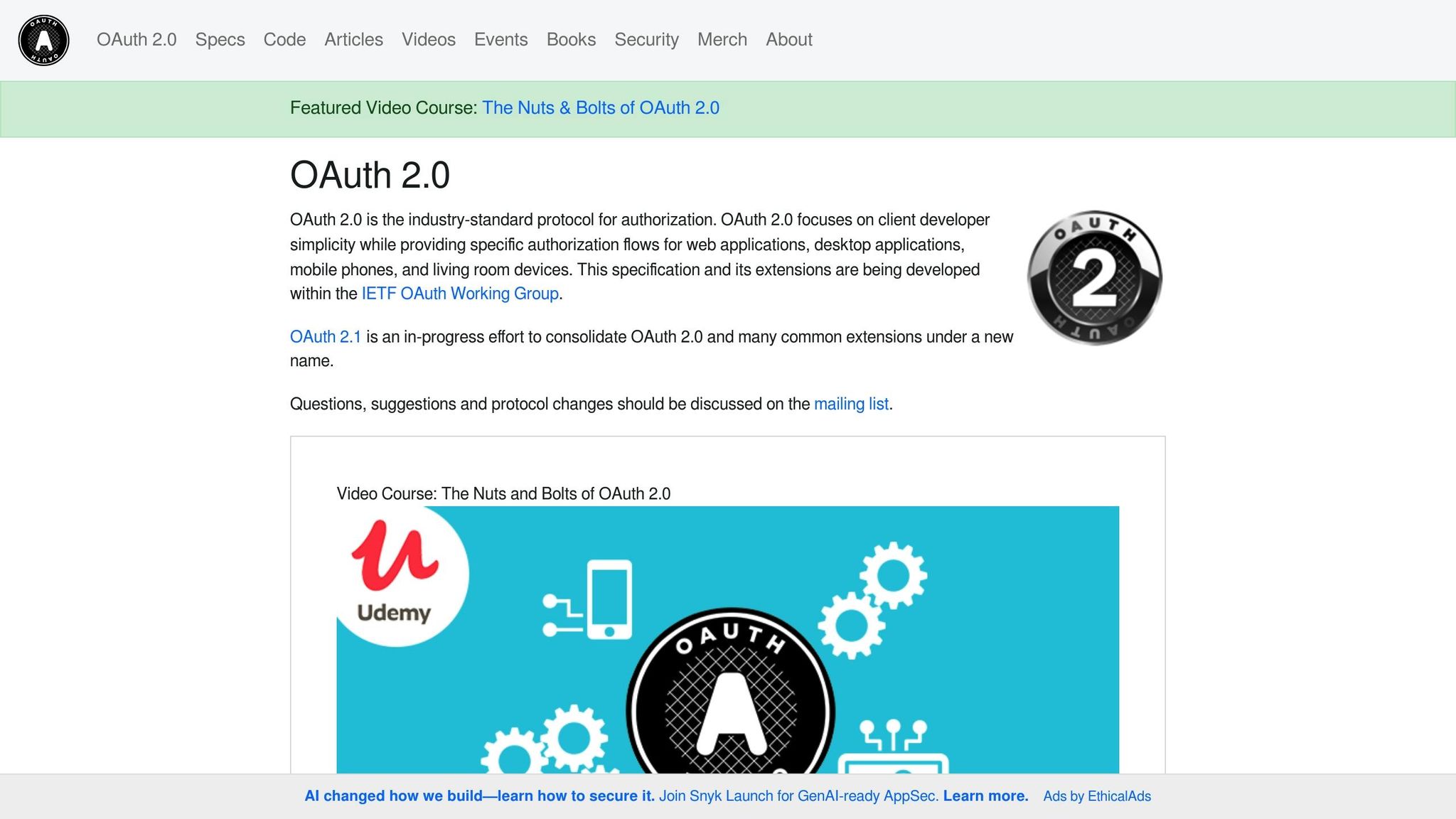APIs are responsible for 57% of all internet traffic – making them a primary target for cyberattacks. API gateways act as intermediaries between clients and microservices, protecting sensitive data. But how can you truly secure your API gateway? Here are the key measures:
- OAuth 2.0 and OpenID Connect: Protect data with modern authentication and specific permissions.
- Encryption: Use HTTPS and TLS (at least 1.2) for secure data transmission and store sensitive data encrypted.
- Regular Audits: Check APIs biannually or more frequently for vulnerabilities.
- Access Controls: Implement the principle of least privilege with RBAC and ABAC.
- Monitoring & Logging: Monitor API activities in real-time to detect threats early.
- Rate Limits: Limit API calls to prevent abuse and overload.
- Web Application Firewall (WAF): Block malicious traffic before it reaches your system.
Quick Facts:
- 41% of companies experienced API security incidents.
- GDPR-compliant encryption can avoid penalties.
- Rate limiting reduces server load by up to 40%.
These measures not only protect data but also strengthen the trust of your users. Read on to learn how to implement each of these elements.
API Gateway Security Made Easy!
1. Use OAuth 2.0 and OpenID Connect for Authentication

OAuth 2.0 and OpenID Connect are a powerful duo when it comes to securely managing sensitive user data – a crucial point for Gunfinder, where such data is processed daily. While OAuth 2.0 authorizes access to resources, OpenID Connect ensures the identity of users is confirmed. Together, they cover two central aspects of security.
What is the difference between OAuth 2.0 and OpenID Connect?
The difference lies in their function: OAuth 2.0 specifies what an application can access, while OpenID Connect clarifies who is actually using the application. With this combination, you can ensure that both access rights and user identity are accurately verified.
How Implementation Works in the API Gateway
An API gateway can serve as a central instance for verifying JWT tokens. Here, access to resources is determined based on the defined scopes. The claims contained in the token are then forwarded to the backend services so they can receive the necessary information.
Instead of granting blanket access rights, you should use specific OAuth scopes. In a microservices architecture, each service can have its own client credentials. Through the OAuth 2.0 Client Credentials Flow, each service authenticates with exactly the permissions it needs – no more, no less.
Additional Security Measures
For higher security, you can take the following measures:
- mTLS (mutual TLS): Strong authentication between client and server.
- Token Binding: Protection against token theft.
- Regular rotation of client secrets: Reduces the attack surface.
- Rate Limiting: Blocks brute-force attacks.
Additionally, you should ensure that all relevant token attributes such as signature, expiration time, and claims are checked. Limit the scopes to what is absolutely necessary and store client credentials in protected environments. These measures help you create a secure and reliable solution for authentication and authorization in your API gateway.
2. Encrypt Data During Transmission and Storage
While authentication with OAuth and OpenID Connect protects access, encryption ensures that data remains secure and intact during both transmission and storage. It is a central building block for meeting GDPR requirements. Here’s how you can implement security standards for data transmission and storage.
Encryption During Data Transmission
Using HTTPS is a must to secure data transmissions. By employing TLS (Transport Layer Security), data is encrypted, preventing eavesdropping and man-in-the-middle attacks.
Ensure that at least TLS 1.2 is used. Modern WebSocket and HTTP APIs only support TLS 1.2, which already provides a high level of security. API gateways can be configured to enforce TLS for all incoming and outgoing connections to ensure end-to-end encryption.
Encryption of Stored Data
When sensitive data is stored in databases, encryption is particularly important in Germany. The GDPR explicitly requires measures such as data protection by design and by default to protect personal data.
"GDPR does not specifically mandate any particular level of encryption or any other specific technical standard because they may become obsolete quickly due to technological change." - Rupert Brown, CTO and Founder of Evidology Systems
Encryption is highlighted in the GDPR as an important means. Companies can even be exempted from the notification obligation in the event of data breaches if the affected data is encrypted and the keys have not been compromised.
Modern Encryption Algorithms and Key Management
Rely on modern and strong encryption algorithms. When deciding between symmetric and asymmetric encryption, note that symmetric methods are faster, while asymmetric methods are considered more secure due to their public-private key pair.
End-to-end encryption is essential to ensure that data can only be decrypted at the destination. However, security largely depends on the management of encryption keys.
"Ultimately, the security of information protected by cryptography directly depends on the strength of the keys, the effectiveness of cryptographic mechanisms and protocols associated with the keys, and the protection provided to the keys." - NIST SP 800-57 part 1, rev. 5
For key storage, Hardware Security Modules (HSMs) offer the safest option. Avoid hardcoded keys in source code or configuration files. Instead, Key Management Systems (KMS) should be used to automatically generate, secure, rotate, and delete keys.
GDPR Compliance Through Encryption
For companies in Germany, such as Gunfinder, compliance with the GDPR is essential. Violations can result in fines of up to 20 million euros or 4% of global annual revenue.
A Data Protection Impact Assessment (DPIA) helps evaluate whether and to what extent encryption is appropriate for specific data processing activities. Document all encryption measures, including the algorithms used, key management, and the reasons for encrypting certain data types.
3. Conduct Regular Security Audits and Updates
Regular security audits are a crucial building block for keeping your API gateway secure. Given that 84% of companies reported at least one API security breach last year – a significant increase from 78% in 2023 – this is more important than ever. At the same time, global costs for data breaches rose to $4.88 million in 2024. Such audits complement encryption and create a solid foundation for a comprehensive API security strategy.
How often should audits be conducted?
The frequency of audits largely depends on the risk profile of your APIs. Companies like Gunfinder, which process sensitive customer data, should conduct audits at least biannually or even more frequently. For high-risk APIs, quarterly audits are advisable, while medium-risk APIs can be reviewed biannually and low-risk APIs annually. Additional audits should be scheduled for significant changes to the API. In dynamic environments like microservices, weekly or monthly scans are often necessary to stay up to date.
The Process of an Audit
A good security audit follows a clear and structured process. First, the scope and objectives are defined, followed by the identification of the APIs to be audited and potential threats. It is important to gather all relevant architectural and threat information and to review existing documentation thoroughly. As with the integration of identity providers, a consistent review is key to success. The audit process combines automated scans with manual penetration tests to effectively uncover vulnerabilities.
The Right Tools for the Job
Modern tools play a central role in conducting audits. SAST (Static Application Security Testing) analyzes source code, while DAST (Dynamic Application Security Testing) enables ongoing API tests. Particularly effective is the integration of security checks into CI/CD pipelines to detect security issues early. Currently, however, only 13% of companies conduct real-time tests of their APIs – a decrease from 18% in 2023.
Fixing and Monitoring Vulnerabilities
After discovering vulnerabilities, a systematic approach to remediation is crucial. Structured workflows help efficiently resolve issues. At the same time, API activity should be continuously monitored to detect suspicious behavior early. All measures should be documented and verified through re-audits to ensure that vulnerabilities have indeed been fixed. These investments pay off: 57% of companies reported API-related security breaches in the last two years. With proactive security measures, such risks can be significantly minimized and long-term costs saved.
4. Configure Detailed Access Control Rules
After covering authentication and encryption, the next focus is on precisely controlling access rights. This is the core of a secure API gateway architecture. Well-thought-out rules prevent unauthorized access and are particularly important for platforms like Gunfinder that work with sensitive data.
Apply the Principle of Least Privilege
A proven security principle is to assign users and systems only the rights they absolutely need to perform their tasks. This approach reduces the attack surface and minimizes the risk of data leaks. For example, a buyer on Gunfinder only needs read access to product data and write access for orders. Access to seller APIs or administrative functions is not necessary for them.
RBAC and ABAC Use Wisely
Strategies like Role-Based Access Control (RBAC) and Attribute-Based Access Control (ABAC) enable fine-grained control of permissions. RBAC defines access rights based on roles such as "Buyer," "Seller," or "Administrator." ABAC goes a step further and considers additional attributes such as location, time of day, or device type. This ensures that each user can only access the data relevant to their role. Automations like SCIM synchronization and just-in-time access workflows make these approaches even more efficient.
Use Allow Lists Instead of Block Lists
Block lists, which only prohibit certain accesses, are often error-prone. A safer alternative is allow lists, where only explicitly approved endpoints are accessible. This ensures that only the intended audiences have access to specific APIs and effectively prevents unauthorized access.
Avoid Common Mistakes
Overly generous access rights and the lack of fine-grained controls at the API level are among the most common vulnerabilities. Another critical mistake is combining different authentication methods with varying security levels for the same resource. Such inconsistencies can create serious security gaps.
Regular Maintenance and Review
Access control rules are not a one-time affair. They must be regularly reviewed and adjusted to current requirements. Outdated permissions, inactive user accounts, or changed role requirements can quickly become security risks. Validation of incoming JWTs should also be consistently performed, even if they have already been transformed by the gateway.
5. Monitor API Activities and Log Security Events
After setting up access control rules, monitoring your API gateway is the next crucial step. Monitoring and logging go hand in hand to detect threats early and respond quickly. For platforms like Gunfinder, which process thousands of API calls daily, this type of monitoring is indispensable. Let’s look at which metrics and log details can help you identify potential dangers in a timely manner.
Why Continuous Monitoring is Important
API monitoring is key to keeping track of the performance, availability, and security of your APIs. It helps detect errors, latency issues, and security gaps before they become real problems. Given that 83% of all web traffic is handled through APIs, continuous monitoring is not an option but a necessity.
"You can also secure your APIs with comprehensive logging and real-time monitoring. Both work together to provide organizations with a holistic defense against threats." – Wiz
Which Metrics and Logs You Should Capture
API gateways provide integrated tools to monitor, record, and analyze API calls and responses. Thorough logging should include the following data: request and response information, user identities, IP addresses, timestamps, and error messages. These logs serve not only as an archive but also help analyze usage patterns and uncover vulnerabilities.
Detecting Suspicious Activities
Real-time monitoring makes it possible to detect unusual patterns or suspicious activities such as sudden traffic spikes or unusual API calls. Warning signs may include:
- Excessively frequent requests
- Unauthenticated access attempts
- Malicious payloads or injection attempts
- High error rates
"Just because your API security has not been compromised does not mean everything is fine. You should collect metrics and log the usage of your API to detect unwanted behavior." – Michał Trojanowski, Product Marketing Engineer at Curity
Integration with Identity Providers
Connecting to identity providers gives you a central overview of user identities and permissions. ITDR solutions (Identity Threat Detection and Response) continuously monitor user activities, detect suspicious behavior, and alert security teams to suspicious operations. This integration also allows for automated responses, such as blocking IPs or tokens after failed authentication attempts.
Practical Tips for Implementation
- Set up alerts for critical metrics.
- Collect log data from various sources to ensure transparency around the clock.
- Watch for unusual requests, such as iterating over IDs, unexpected headers or data, and customers trying to bypass rate limits.
Examples of Real Threats
In December 2024, it was revealed that Chinese hackers had stolen data from US government workplaces. The attack occurred via a compromised API key from the cybersecurity provider BeyondTrust. Such attacks are costly: In the US alone, API attacks could cause damages of $506 billion in this decade.
Automated Responses as a Protective Measure
Modern monitoring systems offer automated responses to security incidents. These include blocking IPs or tokens, notifying SOC teams (Security Operations Center), or redirecting traffic to honeypots. This automation significantly reduces response time – from an average of 48 minutes to just 51 seconds.
sbb-itb-1cfd233
6. Apply Rate Limits to Prevent API Abuse
After monitoring and logging, rate limits are a crucial step in protecting your API gateway from abuse and overload. As mentioned earlier, rate limiting helps to restrict harmful traffic early. It specifies how often an API can be called within a certain timeframe. For platforms like Gunfinder, which face high API traffic daily, this measure is indispensable.
As DataDome describes it:
"API rate limiting is, in a nutshell, limiting access for people (and bots) to access the API based on the rules/policies set by the API's operator or owner."
The Balance Between Security and User Experience
Good rate limiting must balance security and user experience. Too strict limits could hinder legitimate users, while too loose settings open the door for attackers. The challenge is to configure the limits to minimize false alarms while still effectively protecting against malicious activities.
Overview of Rate Limiting Algorithms
The choice of the right algorithm depends on your requirements. Here are some common options:
| Algorithm | Suitable for | Main Features | Considerations |
|---|---|---|---|
| Fixed Window | Simple implementations | Resets counters at fixed time intervals | Can cause traffic spikes at boundaries |
| Sliding Window | Even traffic | Uses a rolling time window | Avoids spikes but is more complex |
| Leaky Bucket | Stable request processing | Processes requests at a steady rate | Ideal for constant traffic patterns |
| Token Bucket | Variable traffic patterns | Fills tokens over time for requests | Good for sudden traffic spikes |
Practical Implementation of Rate Limits
With dynamic rate limiting, you can reduce server load by up to 40% during peak times without compromising availability. This technique adjusts the limits in real-time based on factors such as server load, traffic, and system performance. An effective strategy combines key-level rate limiting – which controls usage per API key – with resource-based rate limiting, which protects heavily frequented endpoints.
Transparent Communication
Clear communication of rate limiting policies is essential to avoid impairing the user experience. Your API documentation should clearly outline the limits for each endpoint and the consequences of exceeding them. Use rate limit headers to indicate remaining capacity (e.g., remaining requests). In case of exceedances, an HTTP status code 429 with a clear error message and a Retry-After header should be returned. This transparency complements technical measures and facilitates user communication.
Monitoring and Adjustment
Regularly monitor the traffic patterns of your API as well as key metrics such as requests per second, rate limit hits, and 429 errors. Set up alerts for threshold breaches and adjust the limits accordingly. This ensures that your protective measures keep pace with the growth of your API.
The Growing Threat Landscape
The importance of rate limiting will continue to increase as attacks could rise by 996% by 2030. A well-thought-out rate limiting strategy is therefore a central component of a comprehensive API security architecture. It forms the first line of defense and creates a solid foundation for additional protective measures such as a Web Application Firewall.
7. Implement Web Application Firewall Protection
In addition to rate limits, a Web Application Firewall (WAF) is a crucial building block for the security of your API. A WAF serves as an additional layer of protection that intercepts malicious traffic before it even reaches your API gateway. As APIs increasingly come under attack – with 70% of app requests being automated API requests – this protection is indispensable. The next step is to configure the WAF to specifically defend against typical attack vectors.
The Right Positioning of the WAF
The WAF should be placed directly in front of your API gateway. This ensures that every incoming request is checked and cleaned before it reaches the servers. This strategic positioning allows the WAF to analyze incoming HTTP(S) requests and act as a filter for web and API traffic at the application level.
"WAFs play a critical role in API security, serving as an essential component of a multi-layered defense strategy. By detecting and mitigating a wide range of threats in real-time, WAFs help safeguard APIs, protect business-critical sensitive data, and ensure the integrity of online services."
José Carlos Chávez, Security Software Engineer @ Okta, OWASP Coraza co-leader
Protection Against Current Threats
The threat landscape for APIs is continuously worsening: 53% of companies report at least three API attacks per month. Particularly in retail, bot attacks increased by 50% in the second half of 2023. A WAF detects these threats and blocks them by identifying known attack patterns such as SQL injection and cross-site scripting, preventing unauthorized access.
Practical Setup and Best Practices
Start with the detection mode to analyze traffic patterns and minimize false positives before blocking requests. Adjust the WAF rules to cover the OWASP Top 10 Risks and provide rate-based protections against DDoS attacks.
For example, in June 2024, Cloudlytics demonstrated how the combination of AWS API Gateway and AWS WAF enables strong defense against threats. The SQL injection rule from AWS WAF automatically checks incoming requests for harmful patterns, while rate-based rules limit traffic from individual IP addresses to prevent DDoS attacks. This configuration perfectly complements the functions of your API gateway.
Complementary Security Architecture
WAFs and API gateways work hand in hand to ensure comprehensive protection:
| Function | API Gateway | WAF |
|---|---|---|
| Authentication & Authorization | Yes | No |
| Rate Limiting | Yes | No |
| Traffic Management | Yes | No |
| Signature-based Protection | Yes | Yes |
| Web Exploit Protection | No | Yes |
| Input Validation | No | Yes |
| Bot Detection | Limited | Yes |
While API gateways primarily operate reactively and are limited to registered APIs, WAFs provide broader protection.
Regular Maintenance and Monitoring
Keep your WAF rules up to date to address new threats. Connect the WAF logs to a SIEM system to detect unusual traffic patterns. Additionally, you should conduct regular health checks of the WAF.
Integrating a WAF into a multi-layered security strategy creates a strong defense network that protects your APIs and users from the growing challenges in cybersecurity.
Conclusion
The security of API gateways is essential today. With 57% of all internet traffic being handled through APIs, the protection of these interfaces is central. An alarming example: In India, API attacks rose by over 3,000% in the third quarter of 2024 compared to the previous year, amounting to 271 million attacks in just three months.
For companies like Gunfinder, which process sensitive data daily, robust security measures are a must. Technologies like OAuth 2.0, encryption, granular access controls, and Web Application Firewalls create multiple layers of protection that ensure both confidentiality and integrity of the data. These measures strengthen the entire infrastructure and provide a high level of protection – a point emphasized by experts as well.
Misbah Thevarmannil explains:
"API security is an essential aspect of modern API security software architecture. It provides a brilliant way for different applications to communicate with each other."
API gateways significantly reduce the attack surface and protect backend services from threats like SQL injection or cross-site scripting. For Gunfinder, this means secure communication between frontend and backend, compliance with data protection regulations like GDPR, and effective protection against attacks. At the same time, they prevent undiscovered vulnerabilities – of which 30% often remain unpatched for long periods – from becoming gateways for attacks such as bot activities or DDoS attacks.
Investing in API gateway security is therefore not only a preventive measure but also a way to strengthen user trust. Secure transactions and compliance with regulatory requirements create a stable foundation for long-term success.
The security practices presented – from authentication to encryption to continuous monitoring – work together like a multi-layered protection system. Each of these measures contributes to ensuring that your API infrastructure remains not only secure but also efficient, even in the face of growing cyber threats.
FAQs
Why is encryption important for the security of API gateways and how can it be implemented correctly?
Why is encryption important for API gateways?
Encryption plays a central role in ensuring the security of API gateways. It ensures that the data exchanged between the API client and the API endpoint remains both confidential and unaltered. Particularly, Transport Layer Security (TLS) is crucial here, as it prevents sensitive information such as passwords or API keys from falling into the wrong hands or being manipulated.
How can encryption be effectively implemented?
- Use HTTPS: Every API request should be made exclusively over HTTPS. This ensures that the data transmission is encrypted.
- Strong authentication and authorization: A solid model for authentication and authorization helps regulate access to the API and prevent unauthorized access.
- Regular security checks: Protocols should be regularly updated and reviewed to counter new security threats and ensure long-term protection.
With these measures, communication over API gateways remains secure and protected.
How can companies ensure that their API gateways are GDPR compliant?
Ensuring GDPR Compliance of an API Gateway
To make an API gateway GDPR compliant, it is crucial to define clear responsibilities. Two roles play a central part: the data controller, who decides on the processing of personal data, and the data processor, who carries out this processing on behalf of the controller. Particularly when using cloud services, both roles can occur simultaneously, making clear delineation and documentation even more important.
Additionally, technical and organizational measures are indispensable. These include:
- Data encryption to protect sensitive information from unauthorized access.
- Access controls to ensure that only authorized individuals can access the data.
- Regular security reviews to detect and address vulnerabilities early.
API gateways provide valuable support by specifically controlling access to data and consistently implementing security policies. Such measures help reduce risks like unauthorized access and ensure the confidentiality and integrity of personal data – a central aspect of GDPR requirements.
How do you conduct regular security audits for API gateways and how often should they take place?
Regular Security Audits for API Gateways
To ensure the security of API gateways, regular audits are essential. Some best practices help identify and address potential vulnerabilities early:
- Update security policies: Regularly review whether your policies withstand current threats and adjust them as needed.
- Use automated testing: Vulnerability analysis tools can help quickly uncover potential risks and take timely action.
- Monitor and log activities: Continuous monitoring allows for immediate detection and response to suspicious activities.
- Train the team: Ensure that your team is always informed about the latest security measures and potential threats.
It is recommended to conduct audits at least quarterly. However, if significant changes are pending or new threats arise, it may be sensible to schedule reviews more frequently to close security gaps in a timely manner.





























